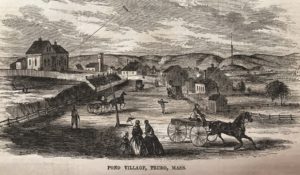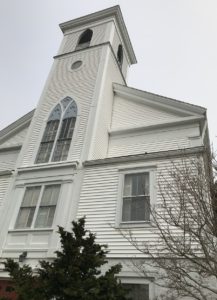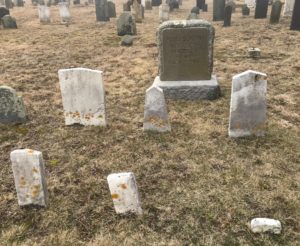In a corner of Truro’s Old North Cemetery is a group of stones with the name Sellew. They were Pond Villagers, as the folks in North Truro were once called, and the name doesn’t seem to appear in any other Truro cemetery. Not by Truro standards a large family, the Sellews — of French Huguenot stock — did marry into the Cobb, Lombard, and Dyer families, as well as the Hughes family, whose Truro roots began with the arrival of Capt. John Hughes from England in the early 1760s.

Were it not for the Revocation of the Edict of Nantes, rescinding the rights of French Protestants to worship freely, the Sellews may never have emigrated from their native Bordeaux. Philip Sellew, born in 1688 and believed to be the ancestor of all the Sellews in America, arrived in Boston in 1713. After living briefly on Martha’s Vineyard, in 1717 this “worthy gentleman” was engaged as schoolmaster in Harwich, a position he held for more than 50 years. Philip and his first wife, Elizabeth, had two sons, John Leland in 1717 and Asa in 1718. A daughter, Elizabeth, was born in 1741 to Philip and his third wife. In July 1763, Elizabeth married John Sears but died, with her 12-day-old baby, the following November.
In 1744, living in Eastham, Asa married Mercy Cobb of Truro. Two sons, Ebenezer and John, were born in Eastham before Asa’s death in 1747 (he is likely buried in Cove Burial Ground), after which Mercy moved to Truro where young Ebenezer, who died in 1752, was buried at Old North Cemetery. In 1749, Mercy married Gamaliel Smith.
Capt. John Sellew (1746-1820), a Revolutionary War veteran, and Hannah Lombard had eight children. The eldest, named Asa for his grandfather, was born in 1775. The family was not spared the scourge of childhood disease, three sons dying in childhood and a fourth at age 26. They share a headstone in Old North Cemetery with their parents, the inscription telling the sorrowful story of Capt. John Sellew having outlived his sons and his wife.
In 1799, eldest son Asa married Emme Hughes, the daughter of Capt. John Hughes and Rachel Dyer. Like countless Truro families, they mourned sons lost at sea. In April 1828, the schooner Dart sailed for the Grand Banks, never to be heard from again. On board were Capt. Thomas Sellew, 28, and his brother John H. Sellew, 23. Also on board was Rachel’s brother, Atkins Hughes, married to Jerusha Dyer, who, after her husband’s death, married James Small Esq. of the Highlands.

Another reminder of the Sellew family is the Gothic Revival chapel on Shore Road in the heart of Pond Village. Those pausing to note the harmony of the Christian Union Church are admiring the work of its architect and builder, Amos Sellew, born in 1815. He was another son of Asa and Emme and the younger brother of Thomas and John.
In 1827, Congregationalists had moved from their meetinghouse on the “Hill of Storms” (Old North Cemetery) to their new church in Truro Center, sharing the “Hill of Churches” with the Methodists, who had formed their own society in 1825. In 1840, a small number of worshipers who remained at the old meetinghouse built a Pond Village church whose pulpit alternated between Congregational and Methodist ministers.
Employing a crew of Truro craftsmen whom historian Shebnah Rich called “practical builders, any one of them capable of building a church edifice,” Sellew completed the two-and-a-half-story Union Society Church, with its distinct pointed windows and open bell tower, for $1,900. (In 1882, the church was raised to add a lower story of brick, detracting, some argue, from the overall harmony of the original.)
Married in 1845 to Minerva K. Brown of Maine, by 1850 Amos and his family were living in Boston, where he is listed in the city directory as a stair builder. Between 1846 and 1855, six children were born in Boston. The Sellew family again was not spared the heartbreak of childhood mortality. The first taken was Emme Minerva, who died in January 1851 at nine months from “teething,” a disease that has eluded a precise modern definition. In 1856, two children, Asa Lewis, seven, and Ella, not yet two, died just weeks apart in January, Asa of croup and Ella of what was called “brain disease.” All three children were buried in the family plot in Truro.

That October, Amos Sellew, his wife, and three surviving children boarded a schooner packet in Boston and sailed for Truro with the solemn mission of installing an iron fence around the family graves. Arriving at the outer bar of Truro Harbor a quarter mile from shore, Sellew and the packet’s captain and cook transferred to a smaller boat laden with the iron fence.
Mrs. Sellew, reluctant to go ashore in the “heavily freighted” smaller vessel, watched in horror from the schooner’s deck as the leaking boat capsized and sank, drowning her husband. The captain and cook were able to save themselves.
The inscription on the headstone for Amos and Minerva, who died in 1877, faces the children’s three marble headstones, their parents protectively watching over them. Forming a square around the family plot, four granite footings, still visible with rusted hardware but without their iron fence, are the tangible reminder of a dreadful day and a father’s last devotion.
Editor’s note: A story about the “Hill of Storms” was published on Jan. 23, 2020 and one about the Small family and Highland Light was published on April 14, 2022.



